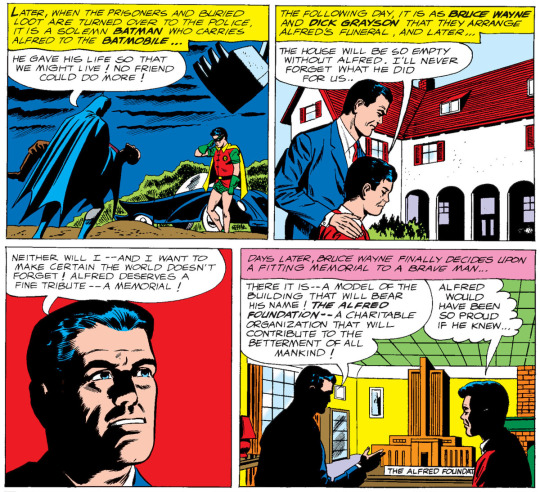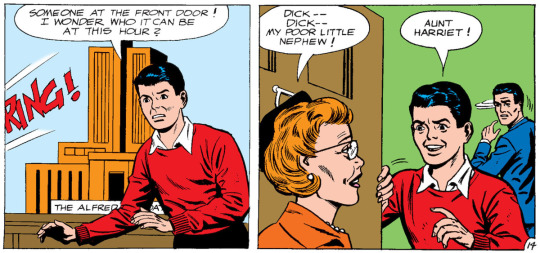#it's hard to fathom now that the batman books were dying
Text

June 1964. A month into Batman's "New Look" period, Alfred the butler is dramatically killed off in DETECTIVE COMICS #328. Writer Bill Finger gives Alfred a suitably heroic demise, sacrificing his life to save Batman and Robin from the Tri-State Gang.

Ouch. This is fairly grisly for Silver Age DC, and, more significantly, obviously intended to be final. (If you're going to seemingly kill off a character with the intent of bringing them back later, "crushed to death by tons of rock right in front of their closest friends" is probably not the way to go.)

Two points of interest here: First, the Alfred Foundation, as will be explained later, is the antecedent of what later became the Wayne Foundation (whose building was redesigned in the early 1970s), which did not yet exist at this point. Second, it's awkwardly obvious here that Alfred had never been given a canonical last name. In one 1945 story, he'd used the name "Alfred Beagle," but that hadn't been mentioned again afterward. The name "Pennyworth" was first used in 1969, five years after this story.
Why did editor Julius Schwartz kill off Alfred, who'd been a staple of the Batman strip since 1943? According to Schwartz, it was to help lay to rest the insinuations that had been floating around for years (especially in the wake of Frederic Wertham's SEDUCTION OF THE INNOCENT a decade earlier) that the Wayne household seemed awfully gay. It should be understood that the modern conception of Alfred as a military veteran and one-time badass didn't arise until the 1980s; since his introduction in 1943, Alfred had been primarily a comic relief figure, and generally a bit of a ninny. Schwartz wanted to replace him with a "a sort of chaperoning den mother," which became Dick Grayson's Aunt Harriet, introduced at the end of this story:

Schwartz claimed that he borrowed the name "Aunt Harriet" from the lyrics of the 1929 Hoagy Carmichael standard "Rockin' Chair." Like Alfred, she didn't initially have a last name (the name "Cooper" came from the TV show, and didn't appear in the comics until DETECTIVE COMICS #373). In the comics, she was not as old or quite as matronly as Madge Blake, who played the character on TV; she was perhaps a decade older than Bruce Wayne.
I'm a little skeptical of Schwartz's assertion that his goal in killing off Alfred in favor of Aunt Harriet was to make Bruce and Dick seem less gay. If that was the plan, it wasn't terribly effective: For one, as the TV show demonstrated, her presence in the Wayne household hardly decreased the camp factor, and the principal dynamic of her comics appearances was to have her nosiness constantly threaten to "out" her nephew and his guardian! Moreover, the "New Look" period actually discarded the three recurring female characters who'd previously been positioned as romantic foils (Batwoman/Kathy Kane, Vicki Vale, and Bat-Girl/Betty Kane) — there would be new ones, but they wouldn't appear for a while, nor did Catwoman (who had been absent since 1956 and didn't return to the comics until 1966) — so Schwartz actually cemented Bruce and Dick's "confirmed bachelor" status, at least for a while.
My guess is that Schwartz, who had been given just six months to turn around BATMAN and DETECTIVE COMICS (whose sales were in very bad shape in 1963–1964), figured that killing Alfred would be an easy way to shake things up a bit. As with the yellow oval Carmine Infantino added to Batman's chest emblem, it was a dramatic but largely cosmetic gesture that didn't really alter the direction of the strip in any very meaningful way.
#comics#detective comics#bill finger#sheldon moldoff#joe giella#bob kane#julius schwartz#new look batman#silver age batman#batman#bruce wayne#robin#robin the boy wonder#alfred pennyworth#harriet cooper#wayne foundation#batman 66#batman tv show#it's hard to fathom now that the batman books were dying#but if you read a smattering of the weirder Schiff-era stories#it becomes clearer#he had been trying to reintroduce more of the batman villains#which was an improvement#but there had been about six years of wall-to-wall aliens
22 notes
·
View notes
Text
Arrietty: Back to (Incredible) Basics
I didn’t realize this until the opening credits played, but The Secret World of Arrietty (2010) makes four adaptations of written stories in a row from Studio Ghibli — Howl’s Moving Castle, Tales from Earthsea, and Ponyo being the other three. I’ll admit that Ponyo is a bit of a stretch, but Hayao Miyazaki has stated that his inspiration was Hans Christian Anderson’s fairy tale, so I’m sticking with it.
Arrietty is an adaptation of Mary Norton’s widely beloved children’s novel, The Borrowers. While it was released as The Borrower Arrietty in Japan, the U.S. and UK releases were titled The Secret World of Arrietty and Arrietty, respectively; I can’t fathom why neither wanted to promote its association with a popular book, but here we are.
These four adaptations make for some interesting comparisons, to the extent that I wonder if there was some sort of strategy meeting held at Ghibli headquarters after Tales from Earthsea squirmed out into the world. That movie, and, to a lesser but still noticeable extent, Howl’s Moving Castle were both stuffed to the brim with mysteries, big ideas, and subplots, and they suffered for it. In contrast, Ponyo and Arrietty are simpler both narratively and thematically, but are astounding in their technical artistic achievements.

Arrietty tells the story of a family of Borrowers, tiny people who live under the floorboards and survive by “borrowing” what they need — such as a cube of sugar, basketball-sized to them — from the full-size humans who live above them. The main focus is on the family’s daughter, Arrietty, who is just old enough to join her father on his borrowing trips. Their comfortable but tenuous existence is disrupted by the arrival of Sean, a sickly young boy who’s been sent to live with his grandmother and her caretaker for some peace and quiet.
These two plot points — the Borrowers’ survival and Sean’s sickness — are really the only plot points of Arrietty. This and the fact that both of these stories are actually addressed and resolved is refreshing after the overcomplicated Howl’s Moving Castle and Tales from Earthsea.

Arrietty is a classic Ghibli protagonist — spirited, independent, and curious. Sean is also compelling; his melancholy brings to mind Princess Mononoke’s Prince Ashitaka and makes an engaging counterpoint to Arrietty’s enthusiasm and determination. The two are voiced by Bridget Mendler and David Henrie, whose resumés both largely consist of various Disney Channel shows. Fellow Disney Channel alumnus Moisés Arias (he was also, bizarrely, Bonzo in Ender’s Game) joins the cast as the fun-but-racistly-designed Spiller.
The adults of the cast pulled in a bit more star power — Arrietty’s parents, Pod and Homily, are voiced by Will Arnet and Amy Poehler. It’s easy to hear the Batman in Pod’s gravelly seriousness, but Arnet manages to infuse equal amounts of gravel and affection into Pod’s sparse dialogue. Poehler, meanwhile, gets some of the movie’s best dialogue as the anxious Homily; the character easily could’ve been obnoxious, but, as 6 seasons of Parks and Recreation can attest, Poehler is relentlessly charming and elevates each line she’s given.
There’s great characters and voice acting in Arrietty, but where the film really shines is in the presentation. Studio Ghibli uses the diminutive size of the protagonists as a chance to show off — throughout the movie, details of animation and sound design reinforce the tiny scale of the world we’re viewing.

Visually, these reminders come in two forms: the creative ways that the Borrowers re-purpose (downscale?) the things they borrow, and the details with which the animators pack each shot.
The Borrowers’ ingenuity is a lot of fun to look out for throughout the movie, from stamps as wall art to soda can pop-tabs used to hang soup ladles. I can’t say how many of these were thought up by the Ghibli team and how many are pulled from the novels, but either way, they point to a well-thought-out world and add a great deal of charm.
The animation details, despite everything, blow me away. I feel Studio Ghibli shouldn’t be able to surprise me anymore, but by scaling down the action, they created new opportunities to impress. The premise allows for details like the grain of the wood inside the walls, rough but worn smooth and shiny, or the way water clings together, pouring out of their tea kettle in bulbous fist-sized drops.
The sound design is similarly effective — a ticking clock can thunder across an entire room, and a giant hand can silence the rest of the world as it closes around a Borrower. It’s clear that the team behind this film saw the Borrower’s size as not just a premise, but a challenge, which they met amply.
There’s a YouTube channel called Every Frame a Painting, probably most famous for their “Marvel Symphonic Universe” video. I happen to think that particular video is pretty off-base, but I love the channel as a whole. I bring them up because of their “Edgar Wright - How to Do Visual Comedy” video. It’s a great video, which you should watch, but the thrust of it is that the humor in Edgar Wright’s comedies doesn’t rely solely on dialogue like in many other comedies. The video posits that, if all your humor comes from funny dialogue, you’re throwing away the visual aspect of the medium — why not tell the story in a novel, or a podcast, or a stage play?

This is a roundabout way of saying that Arrietty feels like a film that is truly firing on all cylinders. The premise, characters, animation, and sound design all reinforce one another; they feel deliberately interwoven in a way that few films do.
Like many Ghibli movies, in a thematic sense Arrietty didn’t exactly leave me satisfied, but that same dissatisfaction has kept me thinking about the movie weeks after seeing it. (Vague spoilers ->) Sean’s attempts to help the Borrowers largely leave them worse off than before; does that mean he should have done nothing? Or did he just need to be more thoughtful? Are the Borrowers at fault for being too suspicious? It’s hard to agree with that when there’s ample evidence supporting their behavior. (<- End spoilers) These kinds of questions mean that, even the movie lacks a certain catharsis, it inspires further thought in a way that a lot of entertainment doesn’t.
Up Next:
From Up on Poppy Hill! Goro takes a second stab at directing — let’s see if he learned his lesson from Tales from Earthsea, shall we?
Alternate Titles:
Arrietty: Ah, That’s Better
Now You’re Just Showing Off, Mr. Miyazaki
“Arrietty, Kids?” “Aye Aye, Captain!”
Stray Notes
The crow and bird fighting are a great The Cat Returns callback
”can I have some warm milk?” You go sneaky Sean, this kid rules
Has Mr. Ghibli ever seen a boy that wasn’t skin and bones?
*sees raccoon* haha sick Pom Poko reference
Wish I had a Lego Batman dad
And a Leslie Knope mom
DON’T RUN SEAN YOU’RE SICK
Why do they randomly emphasize the T sound in Arrietty sometimes (ARE-ee-eh-dy vs. AIR-ee-EH-tee)
Yooooo Spiller is tsundere AF
TOM HOLLAND voices Sean in the UK version??? And it was his first role in anything ever????
168 notes
·
View notes